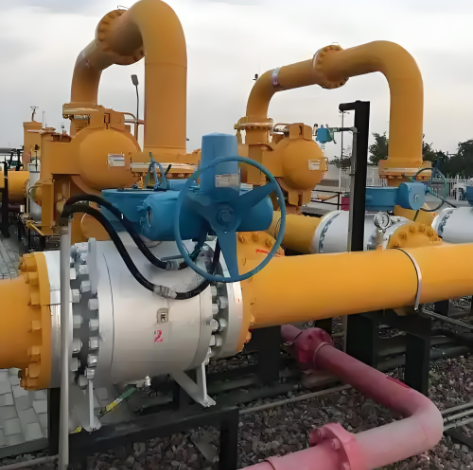In many different sectors, industrial ball valves are essential. They aid in regulating liquid and gas flow. However, its temperature range determines the appropriate valve.
Why does temperature matter when it comes to industrial ball valves? Because temperature has an impact on a valve's performance, it matters. Special materials are required for valves used in areas that are extremely hot or cold. Accidents, damage, or leaks might result from using the incorrect valve.
Selecting a valve with the appropriate temperature range aids in problem avoidance. It ensures the valve operates safely and has a longer lifespan. This article outlines the factors to take into account when selecting a valve for a range of temperatures.
A valve's operation is influenced by the temperature of the fluid passing through it. The strength of the material can be altered by hot or cold fluids. If the valve isn't made for certain temperatures, this could result in leaks or failure.
There is a temperature range that each type of valve can withstand. Ball valves, for instance, function best at temperatures between -55°C (-65°F) to 300°C (575°F). A valve may malfunction if it is used beyond its range.
Special materials are required in extremely hot or cold climates. For this reason, understanding the temperature range is crucial. It assists you in selecting a valve that meets the requirements of your system.
One important consideration is the valve's material. PVC is one substance that only functions at lower temperatures. Some are able to withstand both cold and heat, such as stainless steel.
The valve's internal seal is also important. High heat can cause soft seals to melt or deteriorate. Applications that are extremely hot are better suited for metal sealing.
Temperature is also impacted by the valve's design. Certain designs are intended for harsh environments. Selecting the appropriate design improves the valve's performance in your system.
High-Temperature Ball Valves for Industry
High-temperature valves are designed to withstand high temperatures. The operating temperature range for these valves is approximately 200°C (392°F) to 500°C (932°F) or higher. Stainless steel and other durable materials are typically used to make them.
High-performance metals, such as stainless steel, maintain their strength when heated. Unlike other materials, they don't melt or deteriorate as quickly. Because metal seals don't deteriorate as quickly, they are frequently utilized in high-temperature valves.
Other kinds of valves can withstand even hotter conditions, but ball valves are one choice for high temperatures. Butterfly valves, for instance, can withstand temperatures up to 538°C (1000°F). Globe valves can reach 540°C (1000°F), while gate valves can reach 675°C (1250°F).
Numerous industries make use of high-temperature ball valves. They aid in the regulation of hot steam in power plants. The valve must be able to safely manage high temperatures because steam is quite hot.
High-temperature valves control hot chemicals in chemical plants. A robust valve is required to manage some chemicals because they react when heated. These valves are also used in the oil and gas sector to manage high temperatures during refining procedures.
In these industries, selecting the appropriate valve helps to avoid mishaps. It maintains the safe flow of fluids even under harsh circumstances.
Low-temperature valves function best at extremely cold temperatures. These valves can withstand temperatures as low as -196°C (-321°F) and as low as -40°C (-40°F). Because they don't break easily in cold temperatures, materials like brass and stainless steel are utilized.
Special low-temperature valves are known as cryogenic valves. They are designed to withstand freezing temperatures without cracking. These valves frequently use special seal materials since soft seals may shatter in the cold.
At temperatures as low as -272°C (-455°F), gate and globe valves can function. Ball valves are an additional choice, although they need to be made especially for cold environments. Because each type of valve has a distinct restriction, it's crucial to choose wisely.
Ball valves with low temperatures are frequently seen in sectors such as natural gas. In these conditions, gas is frequently kept at extremely low temperatures as a liquid. The gas is kept safe with the aid of a robust valve.
Low-temperature valves are also used in the food business. They aid in regulating flow during freezing and cooling procedures. Ball valves are used to maintain the stability of medications, which in certain situations require low temperatures for safety.
Safe operations are ensured by selecting the appropriate low-temperature valve. It aids in flow management without running the risk of freezing or leakage. This maintains the system's efficiency and safety.
Industrial ball valves from JONLOO are available for both hot and cold applications. Our valves are composed of robust materials that can withstand high temperatures. We provide cryogenic valves for low temperatures and stainless steel valves for high heat.
Our valves offer robust sealing and long-term endurance for high-temperature applications. They are made for harsh conditions, such as those found in chemical and power plants. We provide low-temperature ball valves for chilly applications that are dependable even in subfreezing temperatures.
For safety, it's critical to select the appropriate industrial ball valve temperature range. Your fluid's temperature has an impact on the valve's performance. To withstand these extremes, valves for high or low temperatures need to be constructed from specialized materials.
Refineries and power plants are among the locations that use high-temperature valves. The food, pharmaceutical, and natural gas industries all use low-temperature valves. To satisfy your needs, JONLOO provides both kinds.

